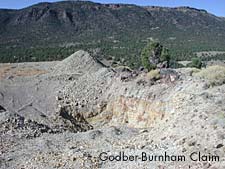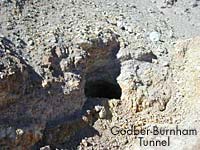 GODBER-BURNHAM
GODBER-BURNHAM
 The
Godber-Burnham mine is located northeast of
Austin, Nevada on Dry Creek. In 1932 Bob Burton
and Joe Potts discovered the mine and first
claimed it as the "Last Chance.”
Later, also being known as the "Blue Stone"
and "Homesite" and at one time the
"Dry Creek" due to its location along
Dry Creek which runs through the Damele horse
ranch and then in front of the Godber claim.
The mine was later sold to Frank Burnham who
it was reported took out more than $100,000
worth of turquoise. In 1934 Burnham sold the
mine to Walter Godber. The
Godber-Burnham mine is located northeast of
Austin, Nevada on Dry Creek. In 1932 Bob Burton
and Joe Potts discovered the mine and first
claimed it as the "Last Chance.”
Later, also being known as the "Blue Stone"
and "Homesite" and at one time the
"Dry Creek" due to its location along
Dry Creek which runs through the Damele horse
ranch and then in front of the Godber claim.
The mine was later sold to Frank Burnham who
it was reported took out more than $100,000
worth of turquoise. In 1934 Burnham sold the
mine to Walter Godber.
 The
turquoise ranges from medium to dark blue sometimes
with a beautiful spider webbing. It has also
been know for a very dark or black mottling
forming blotches and veins running through the
stone. Godber-Burnham has always been considered
a very high quality turquoise. Oscar Branson
in his book, ”Turquoise” has called
Godber "so hard and compact" and "some
of the finest turquoise in Nevada." The
turquoise ranges from medium to dark blue sometimes
with a beautiful spider webbing. It has also
been know for a very dark or black mottling
forming blotches and veins running through the
stone. Godber-Burnham has always been considered
a very high quality turquoise. Oscar Branson
in his book, ”Turquoise” has called
Godber "so hard and compact" and "some
of the finest turquoise in Nevada."
 back to top
back to top
 HACHITA
HACHITA
Hachita turquoise is from a group of mines near
Old Hachita, Grant County, New Mexico. They
include the Azure, Cameo, Galilee, and Aztec
claims. The name "Hachita" comes from
the Spanish term for "Little Hatchet".
The small town itself was located in the foothills
of the Little Hatchet Mountains in the Hachita
Valley of New Mexico. The turquoise deposits
lie in a location known as Turquoise Mountain
about 6 mile west of the town.
Mined intensely in prehistoric times, settlers
first came to the area when stories told by
Indians mentioned turquoise deposits found in
the hills of the Little Hatchet Mountains. Prospectors
began working deposits around 1880’s and
not only found the turquoise, but silver, copper,
and gold as well. Many of the turquoise tunnels
found were so ancient and carefully refilled
by the Indians that they were only found by
later mining. Some were said to have become
so hard that the material had to be blasted
loose.
These were hard mines to work with the nearest
settlement of any size a few hundred miles away
and the harsh furnace like conditions of the
desert. Much of the first turquoise found was
a hard fine pure-blue color. Today the Hachita
turquoise seen in the market place is predominantly
green with a light to dark brown matrix. Sometimes
forming a beautiful spider webbing.
|